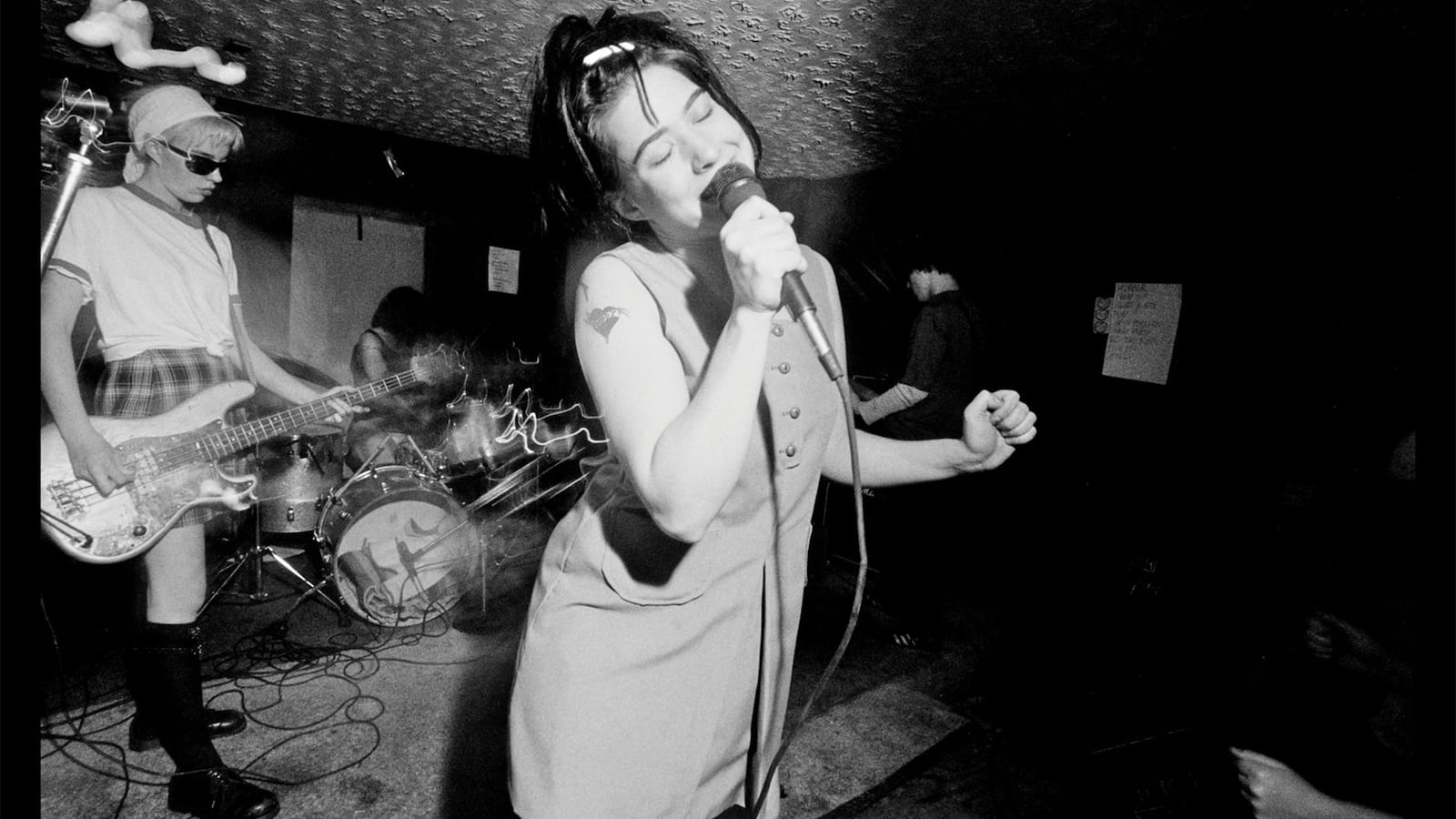The “angry woman rocker” label that stuck to musicians like Paula Cole, Alanis Morissette, and others may have originated with the Riot Grrrl movement. Riot Grrrl began in the early ’90s, when women musicians and activists stormed the punk rock stage to espouse feminist values and protest violence against women. Riot Grrrl–affiliated bands—such as Bikini Kill, Bratmobile, and Heavens to Betsy—forcefully reclaimed girlhood and female anger with howling vocals and blatantly political lyrics. It was stoked by Bikini Kill front woman Kathleen Hanna’s famous demand “Girls to the front” to protect fangirls at their shows from the moshing bodies of male fomenters.
Though music was its loudest megaphone, Riot Grrrl was more of a social movement than a musical one. Activists like Hanna wanted less to join a band than to disseminate a message—that girlhood was under attack, and that it needed to be taken back by girls. Bikini Kill drummer Tobi Vail put it bluntly: “Not only do we live in a totally fucked-up patriarchal society run by white men who don’t represent our interests at all, but we are in a country where those people don’t care if we live or die. And that’s pretty scary.”

For Rebecca Odes, who studied art at Vassar and played bass in the band Love Child, Riot Grrrl was a more accessible form of dissent than sign-waving at protests. “It was basically making art around our anger. It was challenging in a lot of ways popular music definitely wasn’t. It was protest music,” she told me. The first song she wrote, “Asking for It,” dealt with street harassment.
While Riot Grrrl’s wellspring was the punk scene of the Pacific Northwest, adherents brought the movement’s ideas nearer to the seat of power when they moved to Washington, D.C. Riot Grrrls made “fanzines”—handmade publications voicing their ideas that they sold at shows. This was where “The Riot Grrrl Manifesto” was published to outline the movement’s grievances and define its goals.
BECAUSE in every form of media I see us/myself slapped, decapitated, laughed at, objectified, raped, trivialized, pushed, ignored, stereotyped, kicked, scorned, molested, silenced, invalidated, knifed, shot, choked and killed.
BECAUSE I am tired of these things happening to me; I’m not a fuck toy. I’m not a punching bag. I’m not a joke.
BECAUSE every time we pick up a pen, or an instrument, or get anything done, we are creating the revolution. We ARE the revolution.
Riot Grrrls attempted to celebrate and normalize female anger. They organized consciousness-raising gatherings across the country. They protested in the name of simpatico causes, like storming Capitol Hill to fight abortion restrictions, and speaking against sexual abuse and eating disorders. They wrote “slut,” “rape,” and “whore” on their stomachs at performances and protests, and hoisted signs that read “Keep Your Fist Outta My Cunt” and “We Are Not Things.” They boycotted mainstream record labels and cultural influences, ate vegetarian diets, and avoided alcohol and drugs.
Sara Marcus, who would later write the Riot Grrrl’s history, Girls to the Front, was inspired to join the movement by a report about it in Newsweek. “It felt like finally jumping into a lake that’s exactly the right temperature for your body,” she told me. “You would come into a room and there would be an instant sense of recognition. On a cellular level we were made of the same stuff.”

Since Riot Grrrl was wrapped in the twin discomforts of female anger and sexuality, the movement walked a line between a curiosity and a threat. Thus, the news media didn’t know what to do with it. Its efforts were either misconstrued or outright undermined in press coverage. Their representatives were defused or simply written off. Riot Grrrl was categorized as “feminist fury,” “In-Your-Face-Feminism,” and “mean, mad and defiantly underground.”
A 1993 Seventeen magazine article seemed bent on disabling the movement, accusing it of ugliness, misandry, and having a “militant slant.” This was supposedly proved by their look. Riot Grrrls “don’t shave and deliberately give each other bad haircuts,” the report said. Women who didn’t conform to mainstream beauty standards weren’t real women, as both Paula Cole and Riot Grrrl learned. Unsurprisingly, after the press pigeonholed them as combat-boot-wearing man-haters, angry rape and incest survivors, former sex workers, and caricatures of girlhood, many Riot Grrrls dodged interviews.
The Riot Grrrls’ brash optimism and raw passion were also derided as products of youth and inexperience. The movement itself wasn’t particularly cohesive. Girls formed bands or wheat-pasted zines around cities from Olympia to Chicago of their own volition, not by checking in with some central brain trust. The movement was leaderless by design—which made for plenty of complications and factions.

What Riot Grrrl did do was to confer on female anger a real place in the popular culture, which then commercialized it. After Riot Grrrl’s demise, the very qualities it fostered and the “greater acknowledgement of female anger, messiness, and fierceness” that Marcus says it wrought were celebrated in mainstream female musicians and in consumer culture. “There was no attention to angry women before there was Riot Grrrl,” said Marcus. After Riot Grrrl, “then there was an attention to angry women.”
The movement had effectively fizzled out by 1997, as feminists found new affiliations and causes, and associations with Riot Grrrl became more divisive than cohesive. But the ideology and energy reached into the culture in new and expansive ways. So-called angry women rockers flooded the charts and magazine covers, like Fiona Apple and Meredith Brooks, with her anthem “Bitch.” Alanis Morissette’s Rolling Stone cover in 1995 dubbed her “Angry White Female” ahead of the release of Jagged Little Pill. Female rage was selling music and magazines, and minting stars.
Marcus says she once might have written off these “degraded copies” of Riot Grrrl’s ethos as “bullshit commodified versions,” but now she feels differently. “Some women are never going to go to a Riot Grrrl meeting, or have a zine, but are listening to Bikini Kill. Some women are never going to access Bikini Kill, but they’re aware of Hole. Some women aren’t aware of Hole, but they’re listening to Alanis Morissette. Now we’re at a third-generation degraded copy, and at the same time, there’s an embrace of anger and obscenity that does something for people. Even the Spice Girls are like a fourth-generation degraded copy from Riot Grrrl. So a lot of the effect happened firsthand, secondhand, thirdhand, fourthhand.”
Each generation might be more watered down and commodified, but the idea of Girl Power reached more girls all the same. A large part of the Riot Grrrl movement’s legacy is its disappearance into pop culture. What was underground in the early ’90s surfaced aboveground several years later. As Bitch Media founder Andi Zeisler puts it, “Alternative culture in the ’90s was co-opted and made into pop culture.” Despite the movement’s disintegration and lack of recognition, Riot Grrrl certainly deserves credit for introducing Girl Power into the lexicon.
This essay is adapted with permission from Harper Perennial. Excerpt from 90s Bitch: Media, Culture, and the Failed Promise of Gender Equality by Allison Yarrow.






